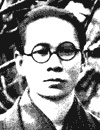|
Gyoshū Hayami
Gyoshū Hayami (速水 御舟, Hayami Gyoshū, August 2, 1894 – March 20, 1935) was the pseudonym of a Japanese painter in the Nihonga style, active during the Taishō and Shōwa eras. His real name was Eiichi Maita. BiographyGyoshū was born in the plebeian downtown district of Asakusa in Tokyo. He studied traditional painting techniques as an apprentice to Matsumoto Fuko from the age of 15. When he was 17, his talent was recognized by Shikō Imamura, who invited him to join the Kojikai circle of leading young artists. With the revival of the Japan Fine Arts Academy (Nihon Bijutsuin), Gyoshū became a founding member. He worked in many schools of painting, including Yamato-e, Rinpa and Bunjinga, with his style evolving gradually towards a detailed realism influenced also by his studies of Chinese paintings from the Song dynasty and the Yuan dynasty. His later works evolved further towards Symbolism. In 1914, Gyoshū formed a group called Sekiyokai to study new styles of Japanese painting. He had a leg amputated after being hit by a train in 1919, but the incident did not affect his artistic output. He devoted himself to creation, submitting numerous works to the Inten Exhibition, as well as touring Europe in 1930. His flower and bird drawings in India ink painting style and his portraits were especially well received by art critics. His most famous work, Dancing in the Flames (炎舞, Enbu) dates from 1925. Gyoshū died suddenly from typhoid fever in 1935 at the age of 40. Over 104 of his paintings were collected by the Yamatane Museum in Tokyo. One of Gyoshū's works, Dancing in the Flames, was selected as the subject of a commemorative postage stamp as part of the Japanese government's Modern Art Series in 1979. In the year 1994, Gyoshū himself was the subject of a commemorative postage stamp under the Cultural Leaders Series by Japan Post. Famous works
References
External links
https://bunka.nii.ac.jp/heritages/detail/488502 https://shae-bear.com/archives/7987
|
||||||||||||||||||||||||||||||||


